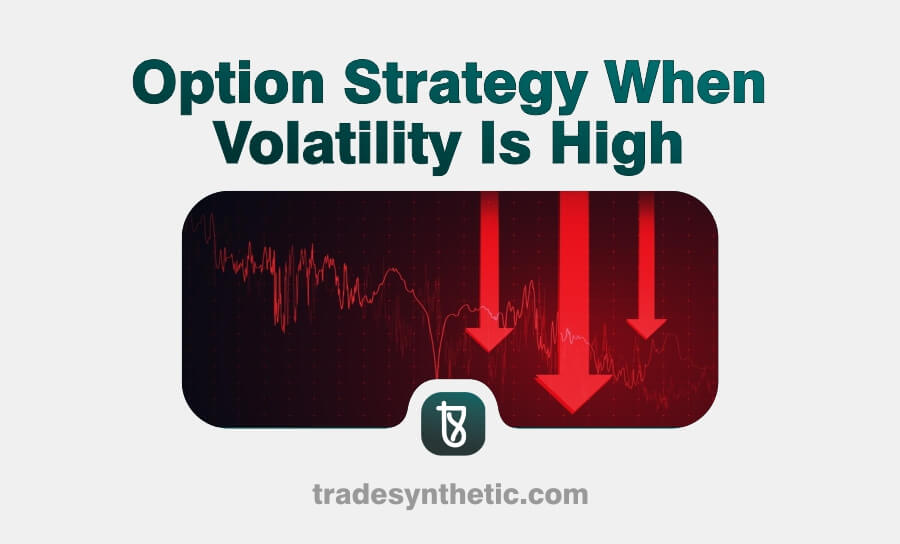The option strategy when volatility is high offers traders who use options techniques intended to profit on large price movements special opportunity. In the realm of options trading, volatility is a key factor in assessing the possible profitability of different approaches. High levels of market volatility provide traders special chances to profit from notable price changes. With an emphasis on their mechanics, benefits, and considerations, this article examines option strategy when volatility is high.
What Is Volatility
Volatility is the degree of fluctuation in a financial instrument’s price over time. Significant price fluctuations are indicated by high volatility, which can be caused by a number of things, including market mood, earnings reports, economic news, and geopolitical events.
Two types of volatility are frequently distinguished in options trading:
- Implied Volatility (IV): This represents the market’s estimates of future volatility based on option prices. Generally speaking, more implied volatility results in higher option premiums.
- Historical Volatility: Historical volatility quantifies how much the price of an asset has changed over a given time period in the past.
Because high implied volatility can result in higher option premiums and possible profit opportunities, traders frequently search for opportunities during these periods.
Techniques for High Volatility
Option strategy when volatility is high can assist traders optimize their potential gains in the face of excessive volatility. The following are the most successful tactics:
Extended Straddle
A common tactic used by traders who anticipate large price movement but are unsure of its direction is the long straddle. This tactic is purchasing a put and a call option at the same expiration date and striking price.
- How It Operates: The trader can earn from one of the options if there is a significant price movement in the underlying asset, either upward or downward. For example, a trader may purchase a call and put option with a strike price of $100 if the stock is trading at $100. The profits from one option may exceed the losses from the other if the stock goes noticeably over $110 or below $90 by expiration.
Benefits:
- High volatility is advantageous for the Long Straddle since it means that both options will gain value if there are notable price moves. Traders can benefit from this method whether or not prices increase.
Considerations:
- The primary risk is that the trader can lose money as a result of time decay if the stock does not move sufficiently to offset the cost of both premiums.
Long Strangle
Buying a call and put option with different strike prices is known as the Long Strangle, and it works similarly to the Long Straddle. When traders anticipate substantial price movement but are uncertain of its direction, they also use this tactic.
- How It Operates: For instance, a trader may buy a call option with a strike price of $105 and a put option with a strike price of $95 if the stock is trading at $100. Because the options are purchased out-of-the-money, this arrangement requires less initial investment than a straddle.
Benefits:
- Profiting from significant price moves in either direction is still possible with the Long Strangle, which can be less expensive than a straddle.
Considerations:
- This approach needs a lot of movement in either direction to be profitable, just as the Long Straddle. Both options can expire worthless if prices stay the same.
Long Put or Long Call
Traders may choose simple methods like buying calls or puts when they have a directional bias because of expected market moves during times of high volatility.
- Long Call: This tactic is buying call options when you anticipate a rise in stock prices. When the price of the underlying asset rises above the strike price, there is a greater chance of profit if volatility increases.
- Long Put: On the other hand, traders can profit from falling stock prices by purchasing put options. If the stock price drops below the strike price before expiration, a long put position turns a profit.
Benefits:
- Leveraged exposure to price fluctuations with minimal risk (the premium paid) is offered by both techniques. They are simple and simple to carry out.
Considerations:
- Because options contain expiration dates and time decay can reduce profits, traders need to precisely forecast both direction and timing.
The Iron Condor
Selling out-of-the-money call and put options while purchasing more out-of-the-money call and put options for protection is known as the Iron Condor, and it’s an advanced trading strategy. When markets stay steady inside a given range during times of excessive volatility, this method makes money.
- How It Works: For example, if a stock is selling at $100, a trader may purchase call and put options at $115 and $85 respectively, and sell a call option with a strike price of $110 and a put option with a strike price of $90.
Benefits:
- The Iron Condor can reduce risk by purchasing options and make money from the premiums it receives from selling options. It performs well in high volatility settings where initial price swings are followed by stabilization.
Considerations:
- Losses may occur if prices deviate substantially from the predetermined range. Therefore, before putting this plan into practice, it is imperative to properly evaluate the state of the market.
Short Straddle
When traders anticipate that implied volatility will decline following an earnings announcement or other noteworthy event, they frequently use the short straddle.
- How It Operates: Traders use this method to sell calls and put options at the same expiration date and strike price. They seek to benefit from time decay as, in the absence of notable changes in the price of the underlying asset, premiums gradually decline.
Benefits
- Lower implied volatility after the event and the ability for traders to earn premiums up front.
Considerations:
- Since there is no limit on how high prices can rise (for calls) or how low they can fall (for puts), the risk is essentially limitless. Only seasoned traders who fully understand the hazards involved should employ this technique.
Market Conditions and Timing
Timing is crucial when using these methods during times of high volatility. Traders should keep an eye on economic indicators, earnings reports, and geopolitical developments that may have an impact on market conditions.
Determining whether options are overpriced or underpriced in relation to historical norms is made easier by comprehending implied volatility levels using measures like IV Rank.
Finding the best entry points to execute trades based on expected market movements can be facilitated by using technical analysis.
In conclusion
For traders using options techniques intended to profit from notable price moves, The option strategy when volatility is high offers special chances. Depending on the state of the market and a trader’s risk tolerance, different strategies—such as long straddles, long strangles, long calls/puts, iron condors, and short straddles—offer unique benefits.
Traders may successfully negotiate choppy markets and increase their chances of making money during times of increased volatility by comprehending the workings of these tactics and closely examining market dynamics. As always, trading decisions in any situation should be guided by careful research and risk management techniques.
Frequently Asked Questions
1. Why Does an Options Trader Need High Volatility?
Option strategy when volatility is high is significant for traders because it affects option pricing and trading techniques. The following happens when volatility is high:
- Increased Premiums: As implied volatility increases, options prices rise as well, giving sellers the opportunity to earn a larger premium.
- Increased Profit Potential: Traders who accurately forecast the direction of a significant price change may see bigger earnings.
- Enhanced Risk: Because prices can fluctuate sharply in any way, high volatility increases risk even as it also offers opportunity.
2. How Can Volatility Be Measured by Traders?
Traders can use a number of indicators to gauge volatility:
- VIX, or the Cboe Volatility Index: The VIX, sometimes known as the “fear index,” gauges market expectations of future volatility by looking at the pricing of options in the S&P 500 index.
- Average True Range (ATR): ATR calculates the average range between the high and low prices of an asset over a given time period in order to quantify market volatility.
- Bollinger Bands: These bands fluctuate according to the volatility of the market; smaller bands denote less volatility and wider bands more volatility.
3. What Is High Volatility
- Significant price swings in a financial asset over a given time frame are referred to as high volatility. It denotes heightened market risk and uncertainty, frequently brought on by news about the economy, corporate results, geopolitical events, or market mood. Because there is a greater chance of significant price swings, high volatility in options trading usually translates into larger option premiums.










